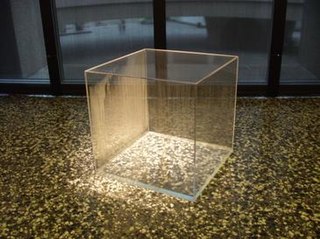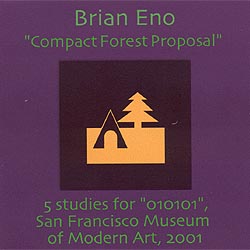
Digital art refers to any artistic work or practice that uses digital technology as part of the creative or presentation process. It can also refer to computational art that uses and engages with digital media.

Generative art refers to art that in whole or in part has been created with the use of an autonomous system. An autonomous system in this context is generally one that is non-human and can independently determine features of an artwork that would otherwise require decisions made directly by the artist. In some cases the human creator may claim that the generative system represents their own artistic idea, and in others that the system takes on the role of the creator.
Computer art is any art in which computers play a role in production or display of the artwork. Such art can be an image, sound, animation, video, CD-ROM, DVD-ROM, video game, website, algorithm, performance or gallery installation. Many traditional disciplines are now integrating digital technologies and, as a result, the lines between traditional works of art and new media works created using computers has been blurred. For instance, an artist may combine traditional painting with algorithm art and other digital techniques. As a result, defining computer art by its end product can thus be difficult. Computer art is bound to change over time since changes in technology and software directly affect what is possible.

Rafael Lozano-Hemmer is a Mexican-Canadian electronic artist who works with ideas from architecture, technological theater and performance. Lozano-Hemmer lives and works in Montreal and Madrid.
Generative music is a term popularized by Brian Eno to describe music that is ever-different and changing, and that is created by a system.

A slide show, or slideshow, is a presentation of a series of still images (slides) on a projection screen or electronic display device, typically in a prearranged sequence. The changes may be automatic and at regular intervals or they may be manually controlled by a presenter or the viewer. Slide shows originally consisted of a series of individual photographic slides projected onto a screen with a slide projector. When referring to the video or computer-based visual equivalent, in which the slides are not individual physical objects.

Thursday Afternoon is the tenth solo studio album by Brian Eno, released in October 1985 on EG Records. Consisting of one 60-minute eponymous composition, it is the rearranged soundtrack to an 80-minute video production of the same title made in 1984.

Marco Brambilla is an Italian-born Canadian contemporary artist and film director, known for re-contextualizations of popular and found imagery, and use of 3D imaging technologies in public installations and video art.
Video painting is a form of video art presented via projectors, LCD or other flat panel display and wall-mounted in the same manner as traditional paintings. Video painting is a relatively new concept that was first coined by Brian Eno in the 1980s to refer to his experimentations with long-form video art. It was later developed upon by Hilary Lawson.

The Shutov Assembly is the twelfth solo studio album by Brian Eno, released on 10 November 1992 on Opal via Warner Bros. Records. One of Eno's ambient albums, it was reissued in 2014 with a second disc with bonus tracks. It is considered the follow-up to Nerve Net, which was released that same year.

Music for Civic Recovery Centre is the nineteenth solo studio album by Brian Eno, released in 2000. Part of Eno's Quiet Club series of Installations, is Eno's third release that has a sole composition.

Kite Stories is the eighteenth solo studio album from Brian Eno, released in 1999 by Opal Music.

"Compact Forest Proposal" is the twentieth solo studio album from Brian Eno, released in February 2001.

Extracts from Music for White Cube, London 1997 is the seventeenth solo studio album from British musician Brian Eno, released in 1997.
Liz Phillips is an American artist specializing in sound art and interactive art. A pioneer in the development of interactive sound sculpture, Phillips' installations explore the possibilities of electronic sound in relation to living forms. Her work has been exhibited at a wide range of major museums, alternative spaces, festivals, and other venues, including the Whitney Museum of American Art, the San Francisco Museum of Modern Art, the Spoleto Festival USA, the Walker Art Center, Ars Electronica, Jacob's Pillow, The Kitchen, and Creative Time. Phillips' collaborations include pieces with Nam June Paik and the Merce Cunningham Dance Company, and her work has been presented by the Cleveland Orchestra, IBM, and the World Financial Center. She is often associated with, and exhibited alongside other early American sound artists Pauline Oliveros, John Cage and Max Neuhaus.

Brian Peter George St John le Baptiste de la Salle Eno, also known by the mononym Eno, is an English musician, composer, record producer and visual artist. He is best known for his pioneering contributions to ambient music and electronica, and for producing, recording, and writing works in rock and pop music. A self-described "non-musician", Eno has helped introduce unconventional concepts and approaches to contemporary music. He has been described as one of popular music's most influential and innovative figures. In 2019, he was inducted into the Rock and Roll Hall of Fame as a member of Roxy Music.

Sergio Maltagliati is an Italian Internet-based artist, composer, and visual-digital artist. His first musical experience with the Gialdino Gialdini Musical Band was in the early 70s.
Tim White-Sobieski is a video and installation artist based in New York and Berlin. He was educated as an architect and dedicated himself to visual art and filmmaking, exploring the fields of painting, sculpture, photography, video, video installations and light installations throughout his career. He began showing in New York in the early 1990s with his "Blue Paintings." Emphasis on the role of the subconscious in his paintings had affinities with visual abstractionism and literary existentialism.
Irma is a 1969 experimental opera by artist Tom Phillips, Fred Orton and Gavin Bryars.

Vivid Sydney is an annual festival of light, music and ideas, held in Sydney, Australia. It includes outdoor immersive light installations and projections, performances by local and international musicians, and an ideas exchange forum featuring public talks and debates with leading creative thinkers.















